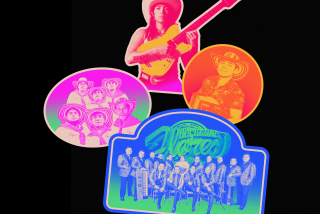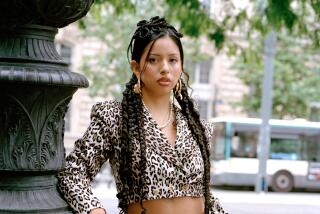A Peruvian Treasure
When slave masters in colonial Peru banned drums, the slaves found new ways to preserve their outlawed rhythms. They used tables and chairs and almost anything that made noise when struck by a bamboo stick or slapped by the palm of a hand.
In the fields, workers expropriated wooden crates as impromptu percussion instruments. They discovered that the crates, emptied of fruits and vegetables, made a surprisingly rich range of sounds, depending on where and how they were struck.
Those humble boxes eventually evolved into a formal percussion instrument called the cajon, now a proud national symbol of Peru. Instead of eradicating the old rhythms and rituals, considered the devil’s work, Spanish church and civil authorities had unwittingly helped create a new genre: the music of black Peru, one of the most vibrant styles in the hemisphere.
Southern Californians will have the opportunity to see the prime exponents of this exciting music in concert for the first time when Peru Negro, a 26-member song-and-dance ensemble formed in 1969 by a former bus driver, makes its U.S. debut tonight at UCLA’s Royce Hall.
Under the direction of its late founder, choreographer Ronaldo Campos de la Colina, the group helped spark a revival of the genre with its showcase of colorful costumes, sensual dances and historic verses that were often preserved through oral tradition.
Its members perform with an array of authentic instruments, including the quijada de burro, a donkey jaw used as a shaker and scraper for its rattling teeth. Their dances, the lando and the festejo, are accompanied by suggestive pelvic movements that once earned condemnation from the dominant white society as immoral, contributing to the music’s once marginalized status.
“There was high-class culture and there was low-class culture,” says Juan Morillo, the group’s U.S. manager and a doctoral candidate in history at Claremont Graduate University. “High-class culture would have been imported. In other words, whatever came from the outside was considered high-class. Black music simply wasn’t recognized until recently.”
Overdue recognition began in the 1950s with the nation’s black artistic revival, led by poet, composer and musicologist Nicomedes de Santa Cruz. Before founding Peru Negro, Campos de la Colina played the cajon with another seminal black group, Pancho Fierro.
In the United States, however, most people are still unfamiliar with Peru’s rich black cultural traditions. When they think of Peruvian music, many think of the Andean folk style, with its mournful pan pipes and flutes popularized by Simon & Garfunkel’s 1970 hit “El Condor Pasa.”
The music of black Peru is earthier, less ethereal. It is the urban music of Peru, cultivated in Pacific coastal towns such as Canete and El Carmen, where Peru Negro was founded. They served as settlements for slaves working the region’s cotton and sugar cane fields.
From these black communities, the music migrated to the capital, Lima, where it survived in segregated black neighborhoods, disparaged and almost forgotten until the renaissance of the 1960s.
This is soulful, melodic music with loping rhythms only distantly related to their more popular Afro-Cuban cousins, such as the son or the rumba. Unlike slaves in Cuba, who were allowed to keep African customs alive in communities with family and tribal ties, the slaves in Peru came from small, unrelated and dispersed groups, a strategy designed to discourage rebellion around tribal chiefs.
Cut off from ancestral memories, black Peruvians developed a distinct style, devoid of African language or santeria religious references, which still infuse its Afro-Cuban counterpart.
The work of black Peruvian artists was first spotlighted in the U.S. on “The Soul of Black Peru,” a 1995 compilation on Luaka Bop Records. It includes songs by Peru Negro and its vocal alumnae Eva Allyon and Lucila Campos, who are today among Peru’s most popular stars, along with Susana Baca, who went on to record solo albums for the label.
Although Peru Negro has traveled all over the world in its 33-year history, concert promoters always balked at the cost of a U.S. tour for a company that numbered almost three dozen members at its peak. Its founder always refused to travel with a pared-down troupe, claiming it would violate its artistic integrity.
Promoters such as Morillo still remember the response of Campos de la Colina, who died last year of a brain hemorrhage at age 73: “We all go, or nobody goes.”
Peru Negro, now under the artistic direction of the founder’s son, Ronny Campos, currently has 26 members. All but four are scheduled to come on this tour, says the group’s lead singer, Monica Duenas, who is married to Ronny Campos and serves as director of a company for children, Peru Negrito.
Duenas recalls how her late father-in-law painstakingly documented the ancient tradition, often relying on tape recordings of songs sung by his mother. One of the most famous old numbers, originally recorded by the group in 1973, was “Toro Mata,” made popular worldwide two years later in a salsa version by Cuban singer Celia Cruz. A more traditional version of the song is included on Peru Negro’s third album, “Sangre de un Don,” released in 2000 on Times Square Records.
Authenticity was a cornerstone of Campos de la Colina’s artistic approach. “He was always very strict about the discipline of the group, so that all the dances would be perfect,” Duenas says. “He was a very proper person in that regard.”
The Lima-based group has remained a family affair, with nieces, nephews, grandchildren, in-laws and even the offspring of former members, says Duenas, 39, whose own children, ages 8, 11, and 16, are now dancing in the group.
“Peru Negro will never die, as long as the family exists,” she says.
*
Peru Negro appears tonight at 8, Royce Hall, UCLA. Tickets are $45, $35, $25 and students, $15. (310) 825-2101.
More to Read
Sign up for Essential California
The most important California stories and recommendations in your inbox every morning.
You may occasionally receive promotional content from the Los Angeles Times.










